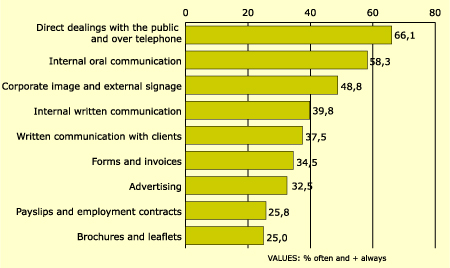Companies selling exclusively to the
Catalan market are from the construction and commerce sectors, whilst those who operate in
the rest of Spain and the international market form part of the industrial sector.
Smaller
companies aim sales at a closer market: the bulk of the business of microcompanies is in
the Catalan market, whereas sales of companies with over 10 employees are mainly made
outside the Catalan market.
3. Use of Catalan in CECOT companies
3.1. The use of Catalan in business
The use of
Catalan in the companies we studied varied considerably according to the type of
communication or the task in question. A total of 66.1% of companies mainly used Catalan
in their direct dealings with the public and over the telephone, and 58.3% mainly used
this language in oral internal communication. Almost one in two CECOT companies used
Catalan in their corporate image and external signage.
Catalan was
used in internal and external written communication in 39.8% and 37.5% of companies
surveyed, respectively, whereas only one in three companies used this language in forms,
invoices and advertising.
The lowest
level of Catalan use was revealed in payslips and employment contracts (25.8%) followed by
leaflets and brochures (25%). These figures translate to only one in four companies using
Catalan in this type of communication.
By sectors,
services employed a moderate use of Catalan, whereas industry had a rather lower level.
Figure 1.
To what extent does your company use Catalan in...?

The use of
Catalan varies substantially according to the type of communication being carried out:
when communication is oral, the use of Catalan increases, but it drops considerably in
written communication. Generally-speaking, however, the Catalan language is widespread and
scores of an average value of 3.1 on a 5-point scale. In these companies, language is used
in two ways: Catalan is used for informal, spontaneous communication and Spanish is used
in formal or institutional contexts.
3.2. Personal customer service
Two thirds of
surveyed companies preferred to use Catalan in their direct dealings with the public and
over the telephone, 21% used Catalan less frequently and 12.8% hardly ever or never used
Catalan in this area. The services sector made substantial use of Catalan in customer
service, whereas industry had a lower use. Companies in Terrassa and the rest of Vallès
Occidental, excepting Rubí, made considerable use of Catalan in their direct dealings
with the public and over the telephone.
3.3. Corporate image and external signage
There are two
clear approaches as regards the use of Catalan in corporate image and external signage,
revealing that companies have a clear idea of the language they need to use for their
image.
Almost one in
two companies analysed used Catalan in their corporate image and external signage, whereas
37.3% never or hardly ever used it. Companies whose activity is based on commerce and
services almost always used Catalan, whereas industrial companies used both Catalan and
Spanish.
3.4. Internal communication
A. Internal
written communication
Internal written communication also reveals a clear dichotomy in language use between
CECOT companies: although 40% often or always used Catalan, 34.3% never or hardly ever
used it. Companies in the services and commerce sector, again, were more likely to use
Catalan in internal written communication than industrial and construction companies.
Microcompanies seldom used Catalan in this type of communication but small-medium
enterprises did so more often.
B.
Internal oral communication
Catalan was always or often used in the internal oral communication of 58.3% of companies
and frequently in 14.8%. However, 26.6% of companies confessed to seldom or never using
Catalan in this type of communication. |
